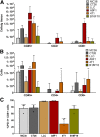18F-AraG PET for CD8 Profiling of Tumors and Assessment of Immunomodulation by Chemotherapy
- PMID: 33158906
- PMCID: PMC8729865
- DOI: 10.2967/jnumed.120.249078
18F-AraG PET for CD8 Profiling of Tumors and Assessment of Immunomodulation by Chemotherapy
Abstract
Most clinical trials exploring various combinations of chemo- and immunotherapy rely on serial biopsy to provide information on immune response. The aim of this study was to assess the value of 18F-arabinosyl guanine (18F-AraG) as a noninvasive tool that profiles tumors on the basis of the key player in adaptive antitumor response, CD8+ cells, and evaluates the immunomodulatory effects of chemotherapy. Methods: To evaluate the ability of 18F-AraG to report on the presence of CD8+ cells within the tumor microenvironment, we imaged a panel of syngeneic tumor models (MC38, CT26, LLC, A9F1, 4T1, and B16F10) and correlated the signal intensity with the number of lymphocytes found in the tumors. The capacity of 18F-AraG to detect immunomodulatory effects of chemotherapy was determined by longitudinal imaging of tumor-bearing mice (MC38 and A9F1) undergoing 2 types of chemotherapy: oxaliplatin/cyclophosphamide, shown to induce immunogenic cell death, and paclitaxel/carboplatin, reported to cause immunogenically silent tumor cell death. Results: In the tumor panel, 18F-AraG revealed strikingly different uptake patterns resembling cancer-immune phenotypes observed in the clinic. A statistically significant correlation was found between the 18F-AraG signal and the number of PD-1-positive CD8+ cells isolated from the tumors (r2 = 0.528, P < 0.0001). In the MC38 model, paclitaxel/carboplatin did not result in an appreciable change in signal after therapy (1.69 ± 0.25 vs. 1.50 ± 0.33 percentage injected dose per gram), but oxaliplatin/cyclophosphamide treatment led to close to a 2.4-fold higher 18F-AraG signal (1.20 ± 0.31 vs. 2.84 ± 0.93 percentage injected dose per gram). The statistically significant increase in signal after oxaliplatin/cyclophosphamide was also observed in the A9F1 model (0.95 ± 0.36 vs. 1.99 ± 0.54 percentage injected dose per gram). Conclusion: The ability of 18F-AraG PET to assess the location and function of CD8+ cells, as well immune activity within tumors after immune priming therapy, warrants further investigation into its utility for patient selection, evaluation of optimal time to deliver immunotherapies, and assessment of combinatorial therapies.
Keywords: CD8 T cells; chemotherapy; immunomodulation.
© 2021 by the Society of Nuclear Medicine and Molecular Imaging.
Figures






Similar articles
-
Imaging of Activated T Cells as an Early Predictor of Immune Response to Anti-PD-1 Therapy.Cancer Res. 2019 Jul 1;79(13):3455-3465. doi: 10.1158/0008-5472.CAN-19-0267. Epub 2019 May 7. Cancer Res. 2019. PMID: 31064845 Free PMC article.
-
[18F]F-AraG Uptake in Vertebral Bone Marrow May Predict Survival in Patients with Non-Small Cell Lung Cancer Treated with Anti-PD-(L)1 Immunotherapy.J Nucl Med. 2024 Dec 3;65(12):1869-1875. doi: 10.2967/jnumed.124.268253. J Nucl Med. 2024. PMID: 39448270 Free PMC article.
-
A Feasibility Study of [18F]F-AraG Positron Emission Tomography (PET) for Cardiac Imaging-Myocardial Viability in Ischemia-Reperfusion Injury Model.Mol Imaging Biol. 2024 Oct;26(5):869-878. doi: 10.1007/s11307-024-01932-y. Epub 2024 Jul 26. Mol Imaging Biol. 2024. PMID: 39060882
-
The role of CD8 PET imaging in guiding cancer immunotherapy.Front Immunol. 2024 Jul 12;15:1428541. doi: 10.3389/fimmu.2024.1428541. eCollection 2024. Front Immunol. 2024. PMID: 39072335 Free PMC article. Review.
-
Refinement of the Lugano Classification lymphoma response criteria in the era of immunomodulatory therapy.Blood. 2016 Nov 24;128(21):2489-2496. doi: 10.1182/blood-2016-05-718528. Epub 2016 Aug 29. Blood. 2016. PMID: 27574190 Review.
Cited by
-
PET Oncological Radiopharmaceuticals: Current Status and Perspectives.Molecules. 2022 Oct 11;27(20):6790. doi: 10.3390/molecules27206790. Molecules. 2022. PMID: 36296381 Free PMC article. Review.
-
The other immuno-PET: Metabolic tracers in evaluation of immune responses to immune checkpoint inhibitor therapy for solid tumors.Front Immunol. 2023 Jan 9;13:1113924. doi: 10.3389/fimmu.2022.1113924. eCollection 2022. Front Immunol. 2023. PMID: 36700226 Free PMC article. Review.
-
[18F]F-AraG imaging reveals association between neuroinflammation and brown- and bone marrow adipose tissue.Commun Biol. 2024 Jul 1;7(1):793. doi: 10.1038/s42003-024-06494-x. Commun Biol. 2024. PMID: 38951146 Free PMC article.
-
Imaging cellular immunotherapies and immune cell biomarkers: from preclinical studies to patients.J Immunother Cancer. 2022 Sep;10(9):e004902. doi: 10.1136/jitc-2022-004902. J Immunother Cancer. 2022. PMID: 36137649 Free PMC article. Review.
-
Imaging immunity in patients with cancer using positron emission tomography.NPJ Precis Oncol. 2022 Apr 7;6(1):24. doi: 10.1038/s41698-022-00263-x. NPJ Precis Oncol. 2022. PMID: 35393508 Free PMC article. Review.
References
-
- Junttila MR, de Sauvage FJ. Influence of tumour micro-environment heterogeneity on therapeutic response. Nature. 2013;501:346–354. - PubMed
-
- Fridman WH, Zitvogel L, Sautes-Fridman C, Kroemer G. The immune contexture in cancer prognosis and treatment. Nat Rev Clin Oncol. 2017;14:717–734. - PubMed
-
- Chen DS, Mellman I. Elements of cancer immunity and the cancer-immune set point. Nature. 2017;541:321–330. - PubMed
Publication types
MeSH terms
Substances
Grants and funding
LinkOut - more resources
Full Text Sources
Research Materials
